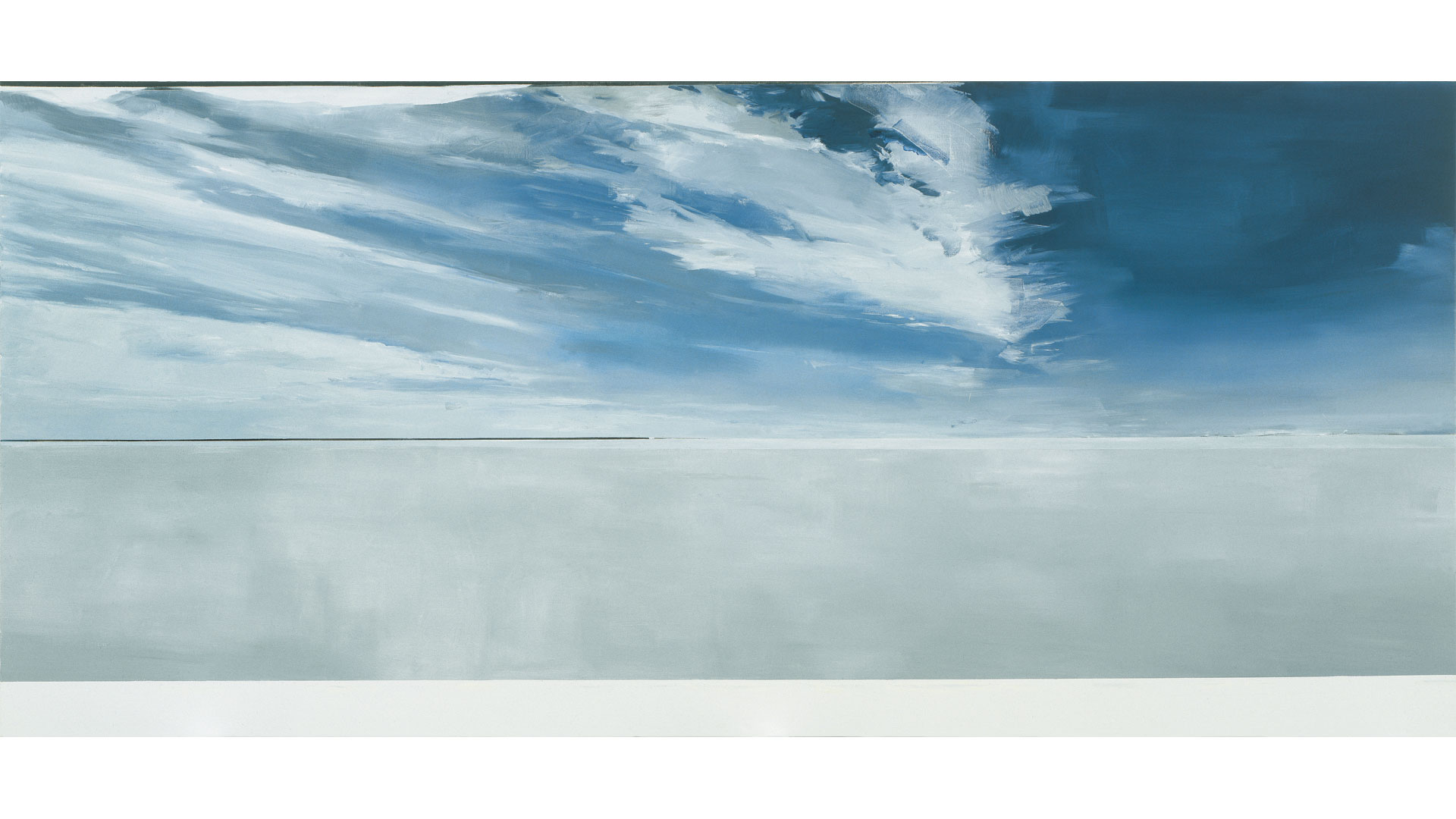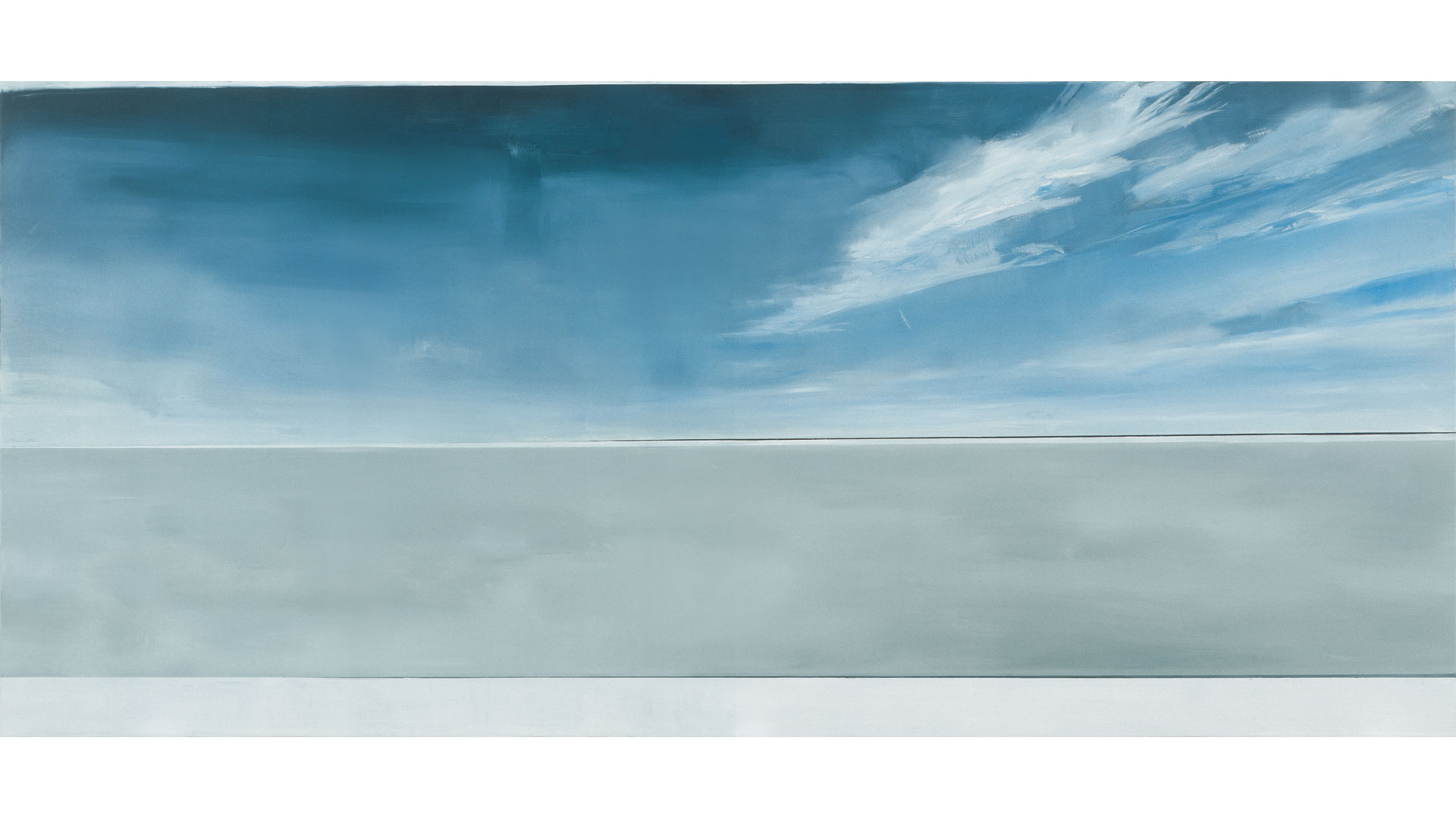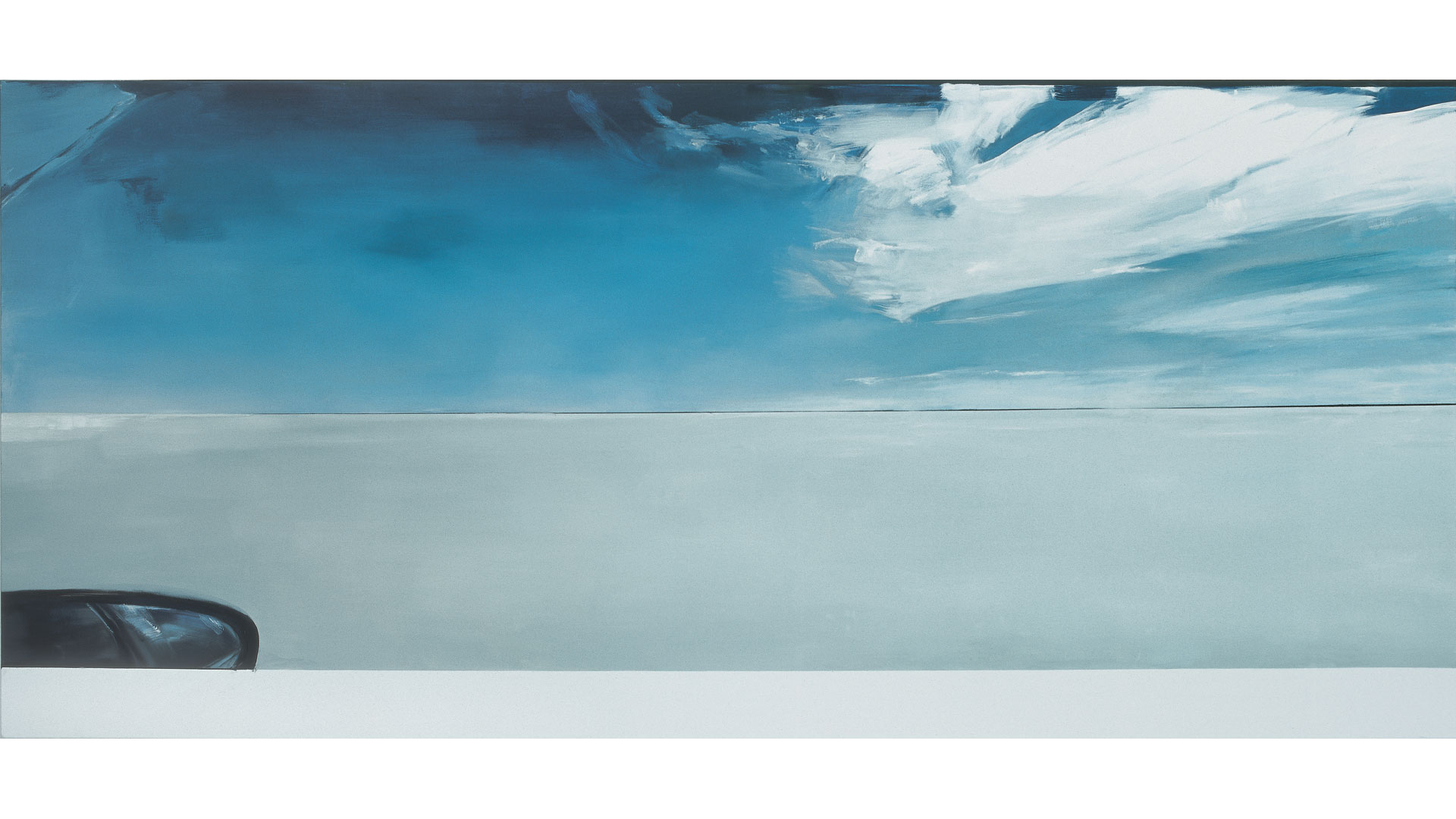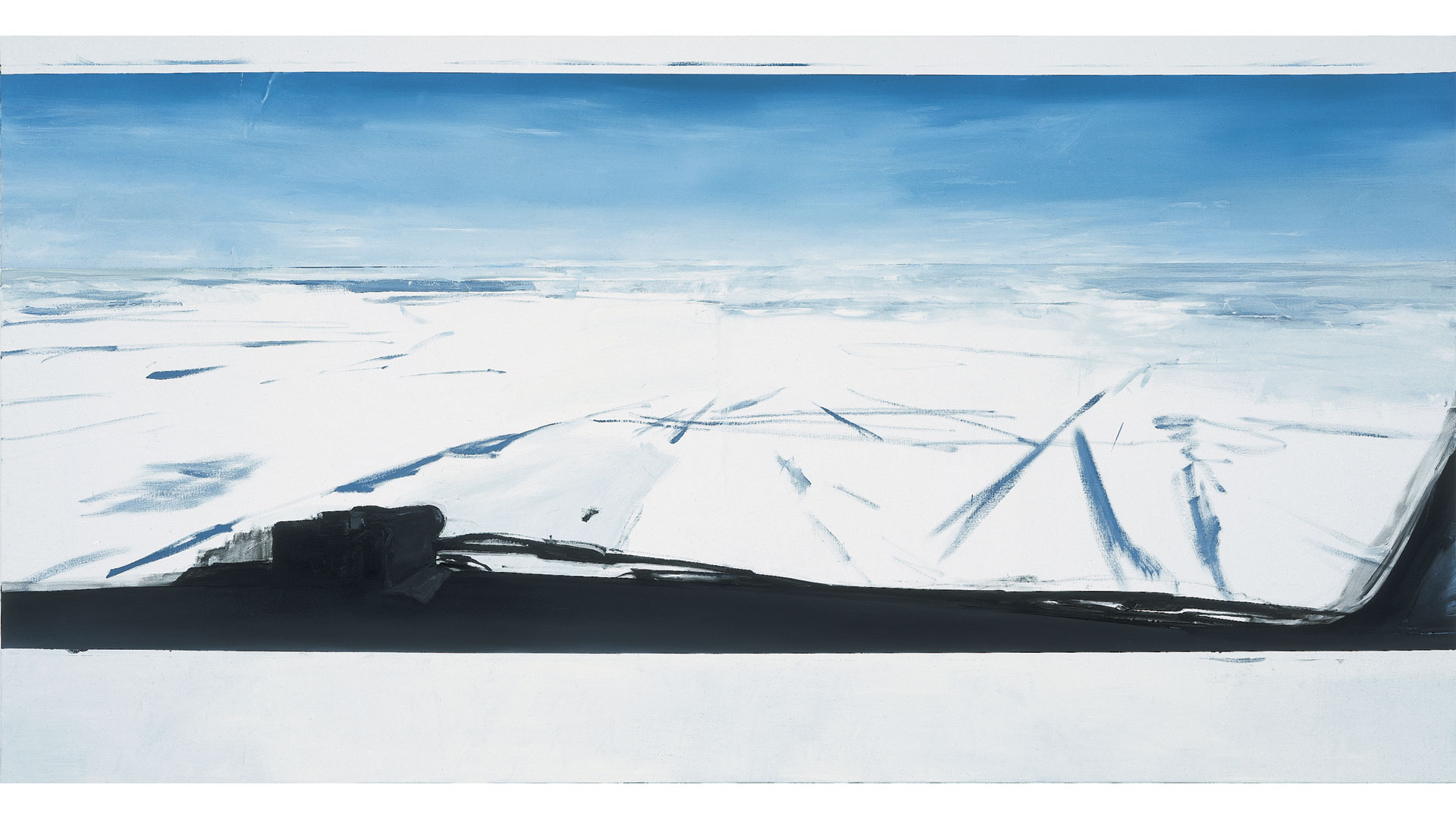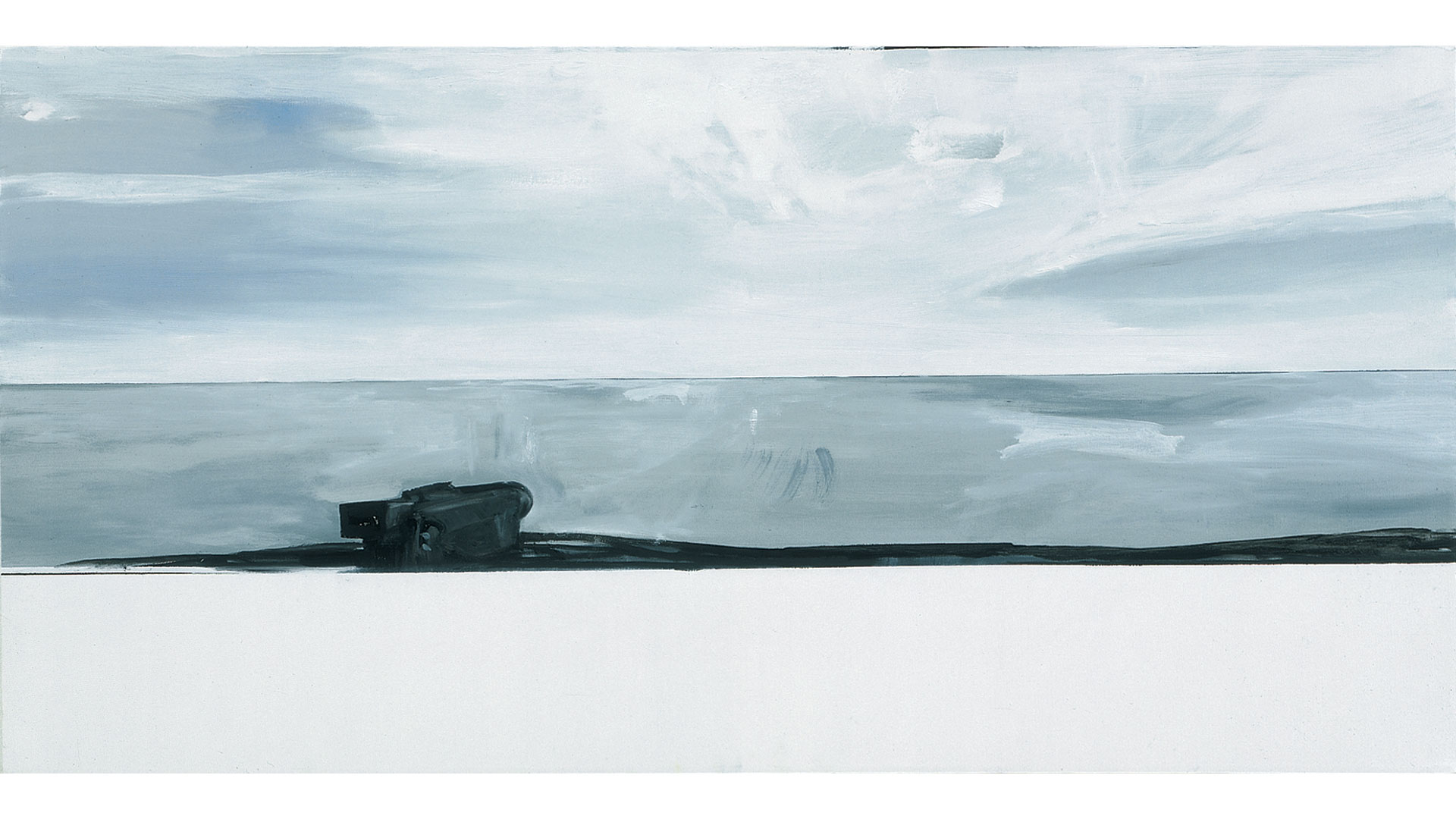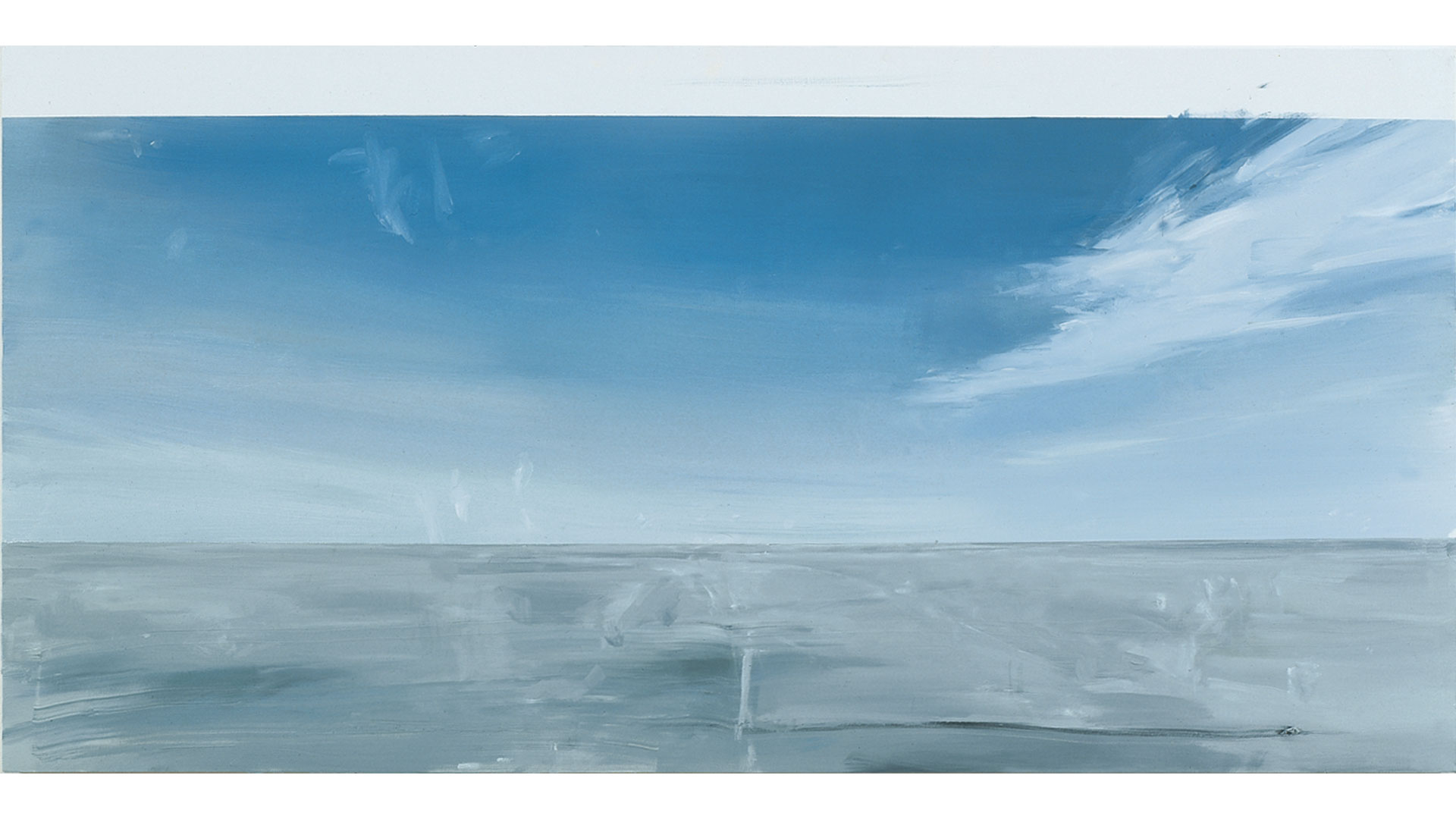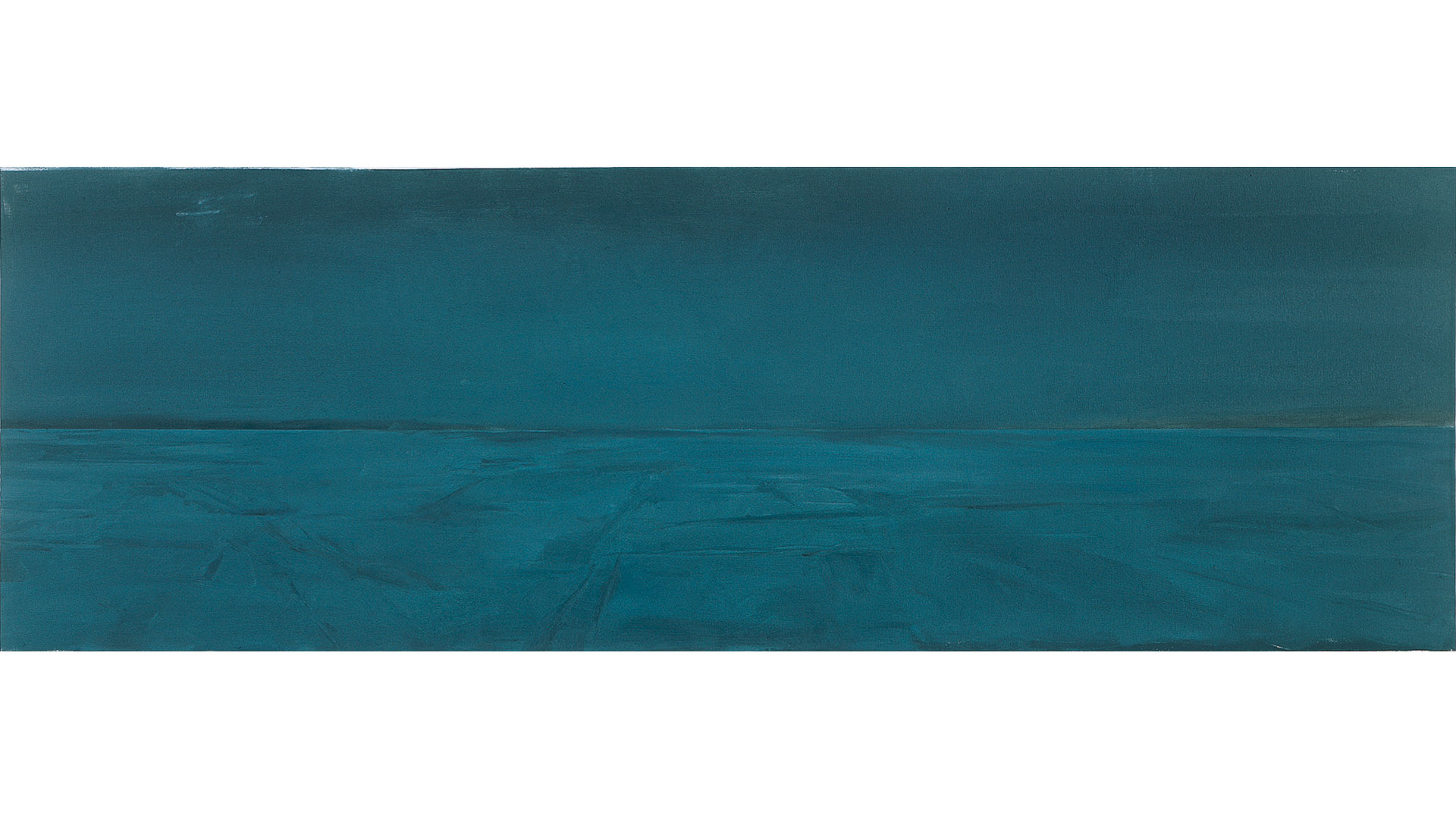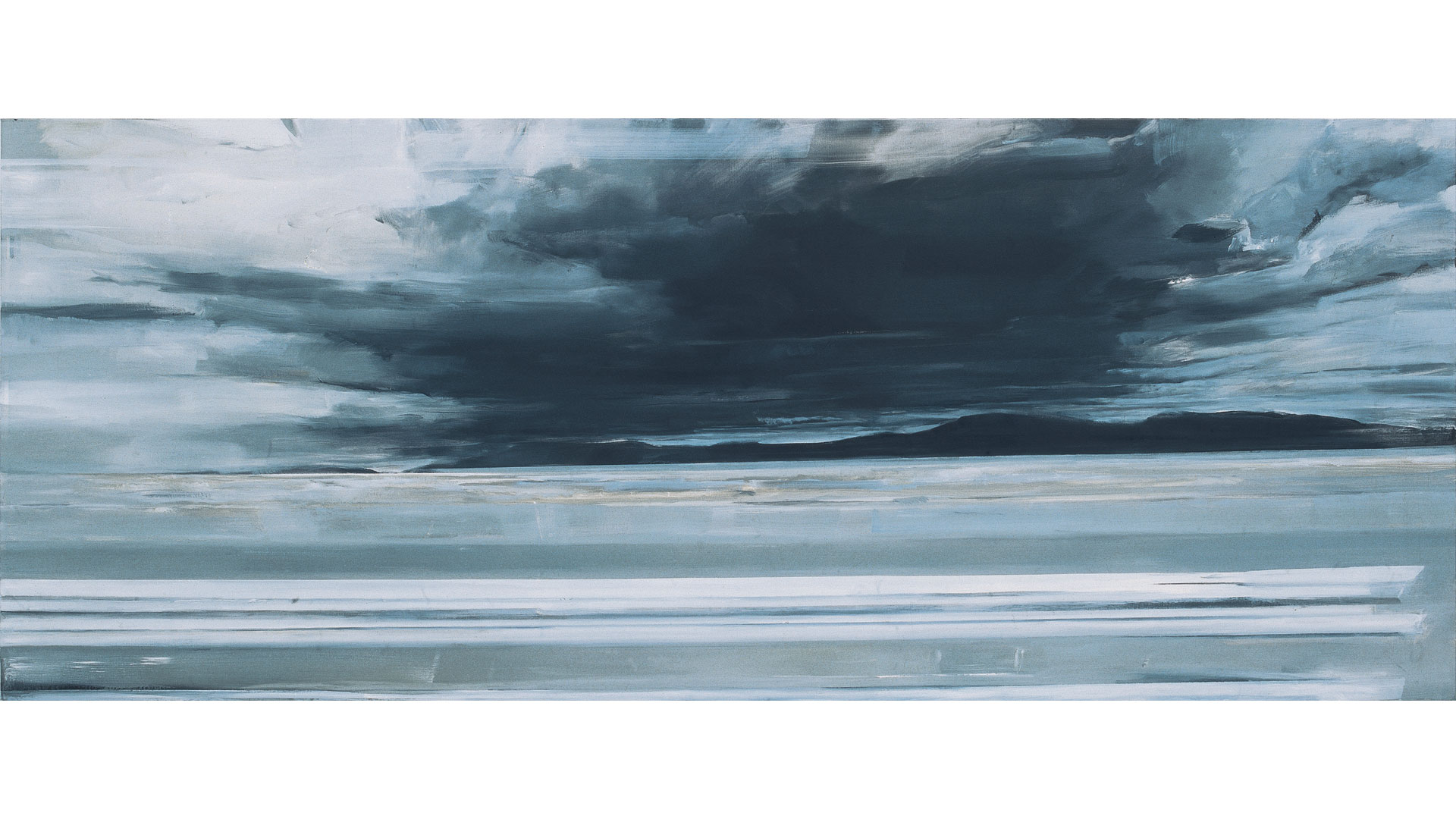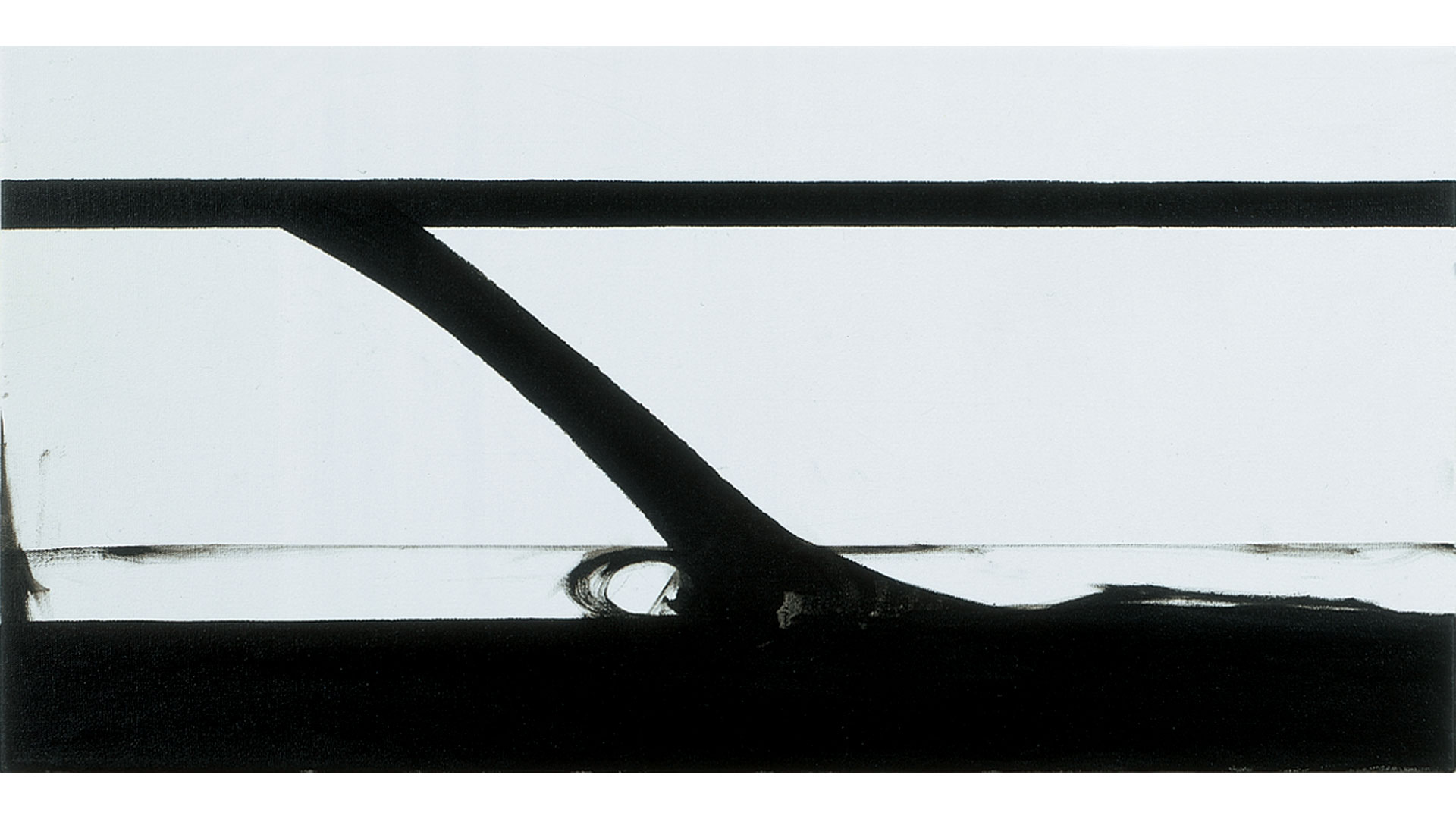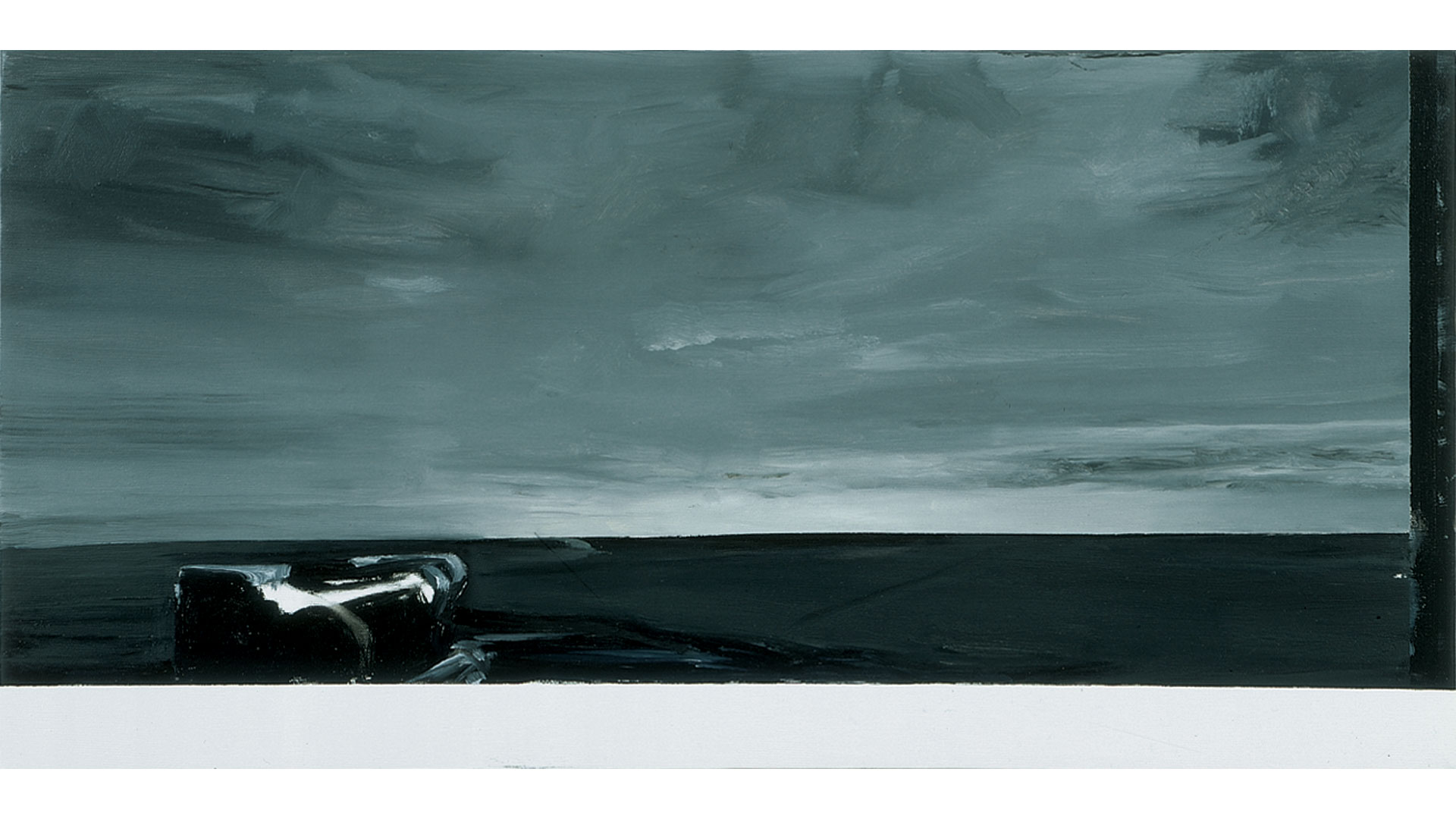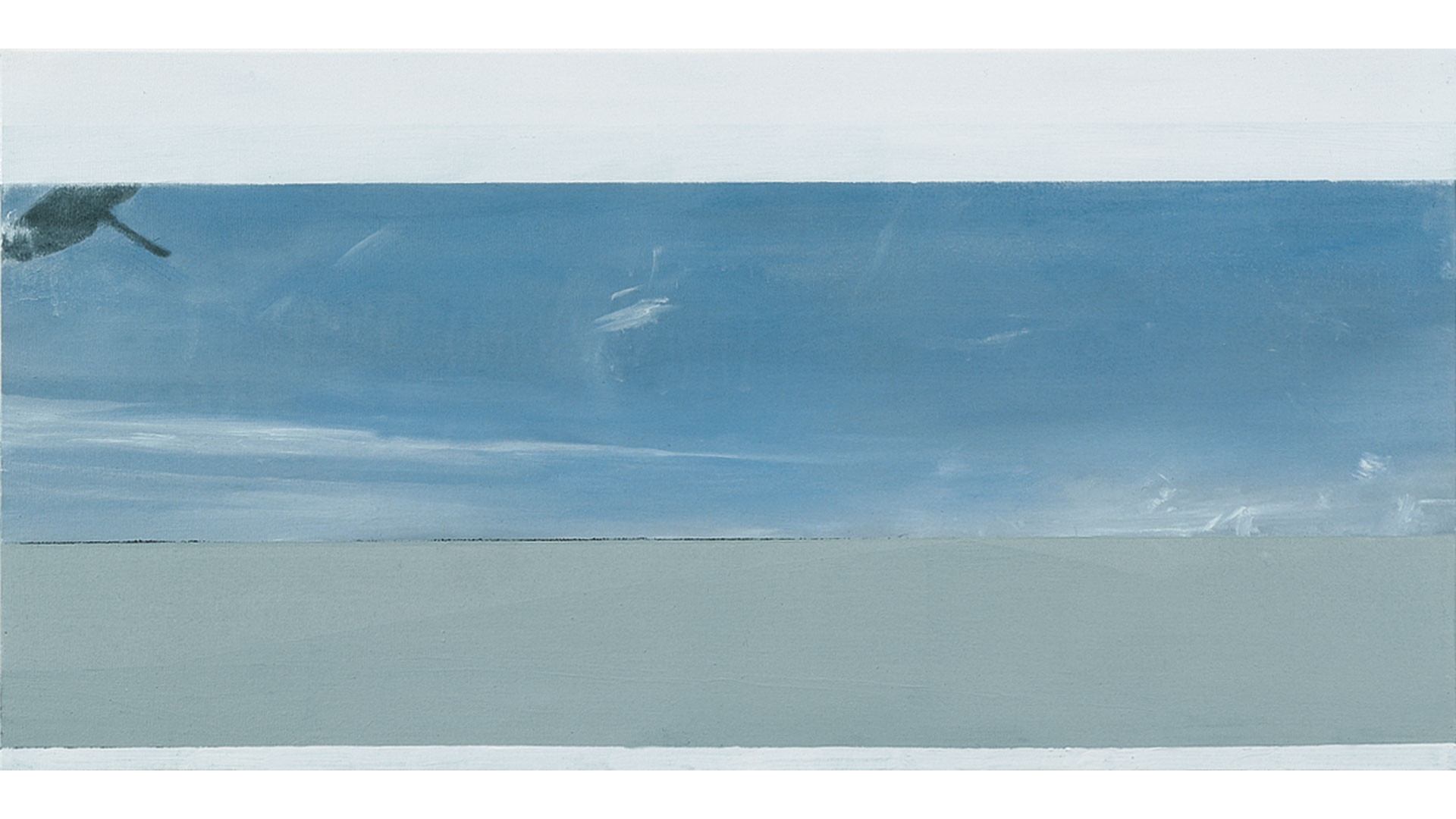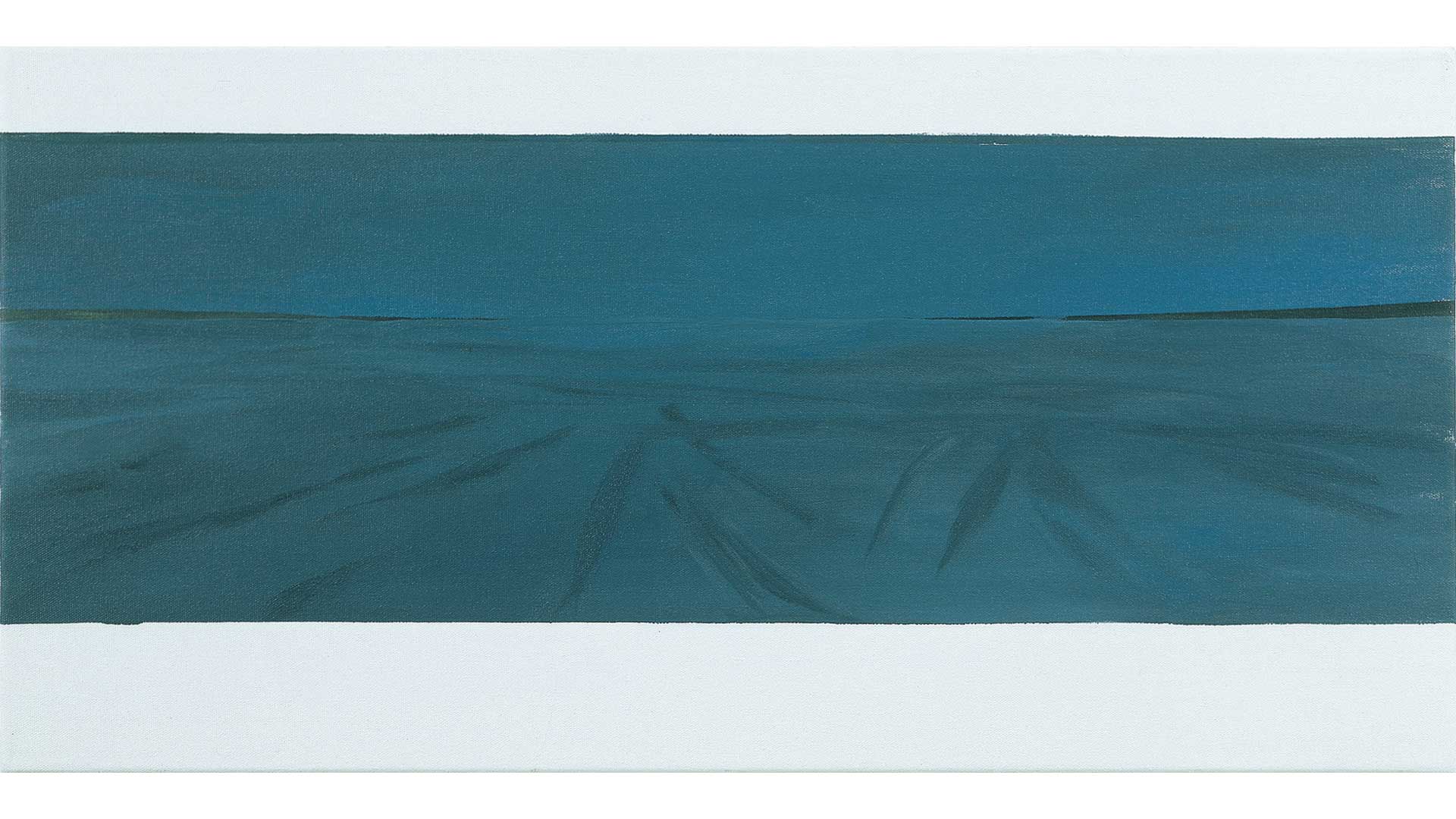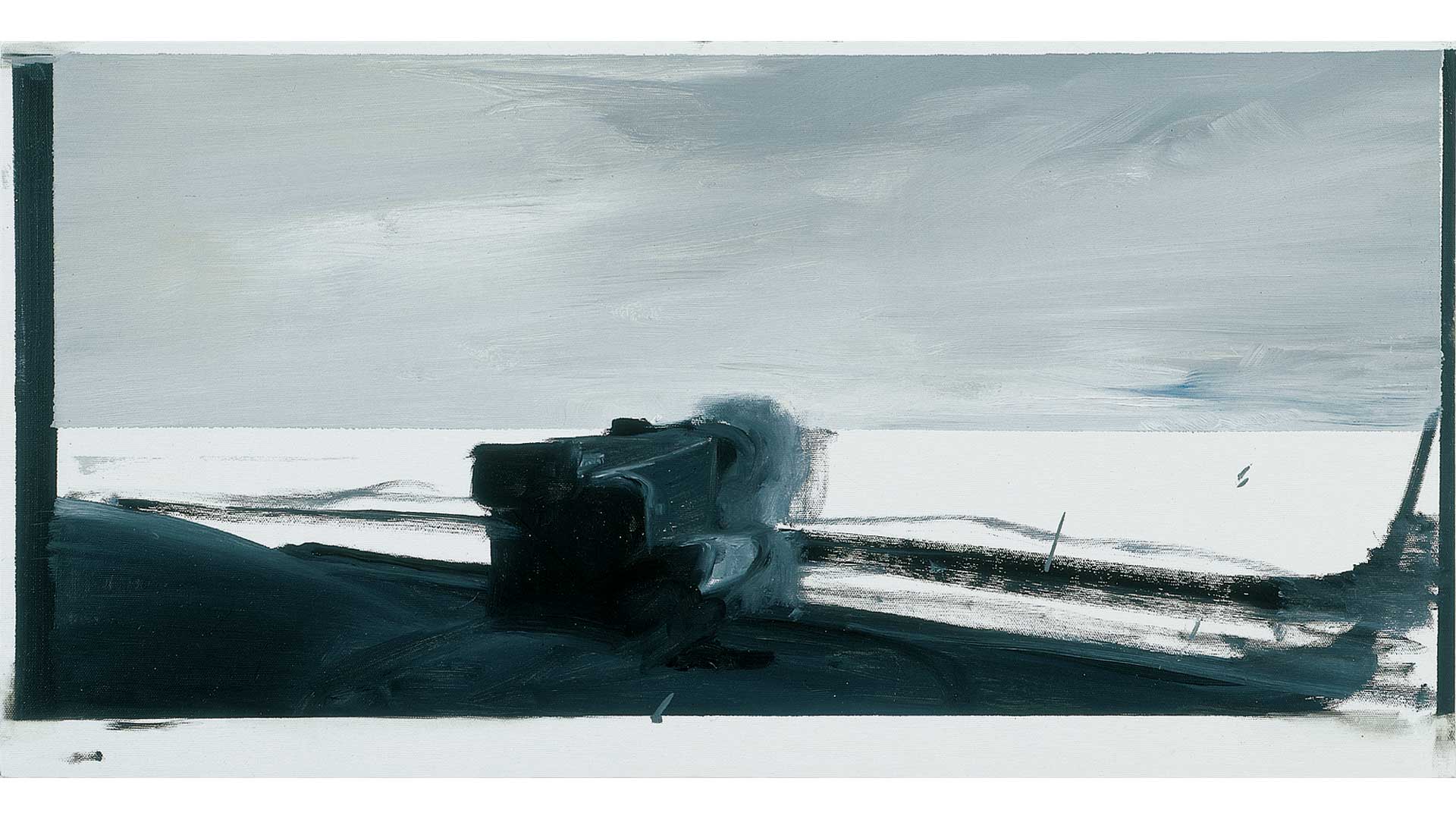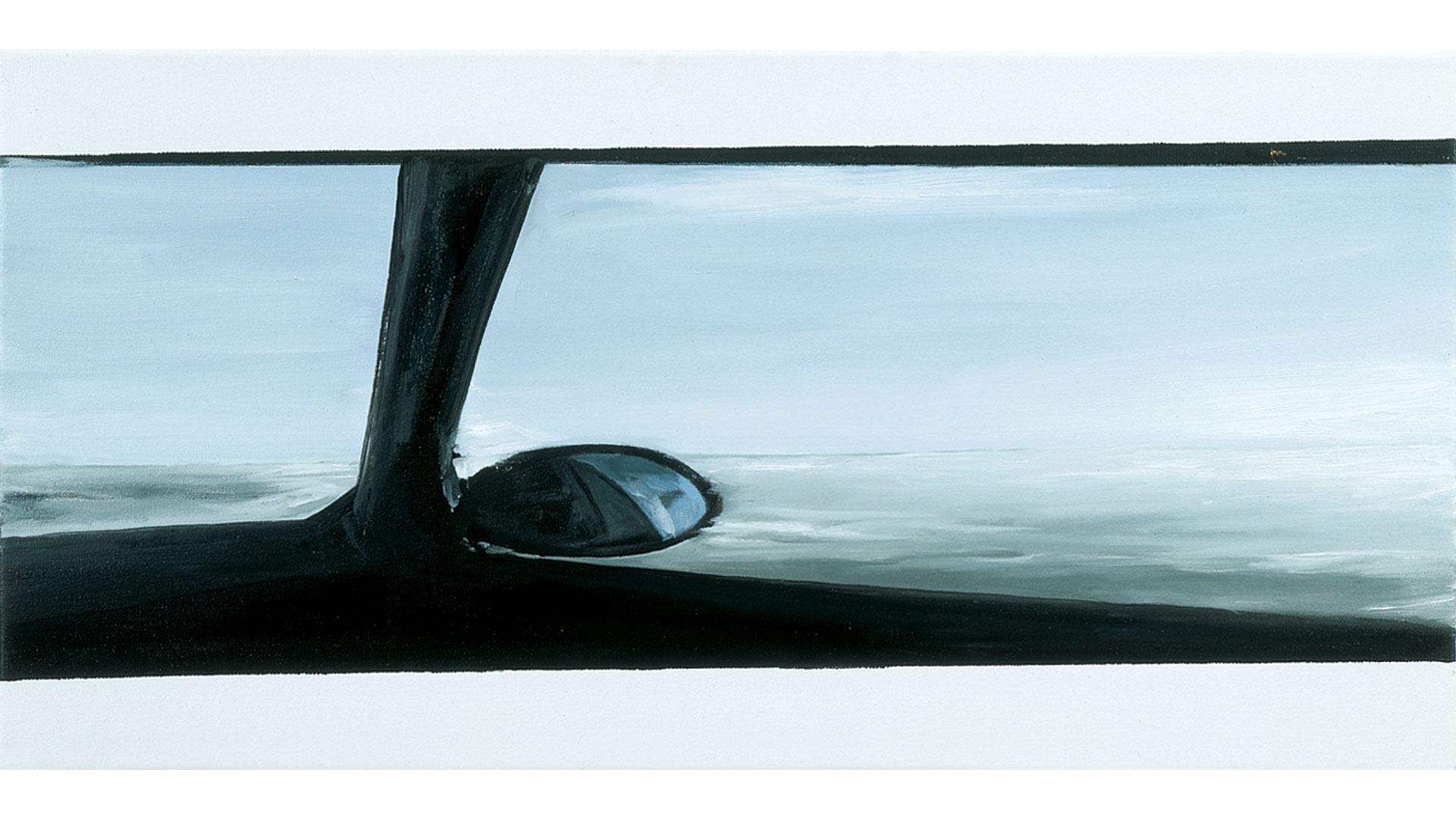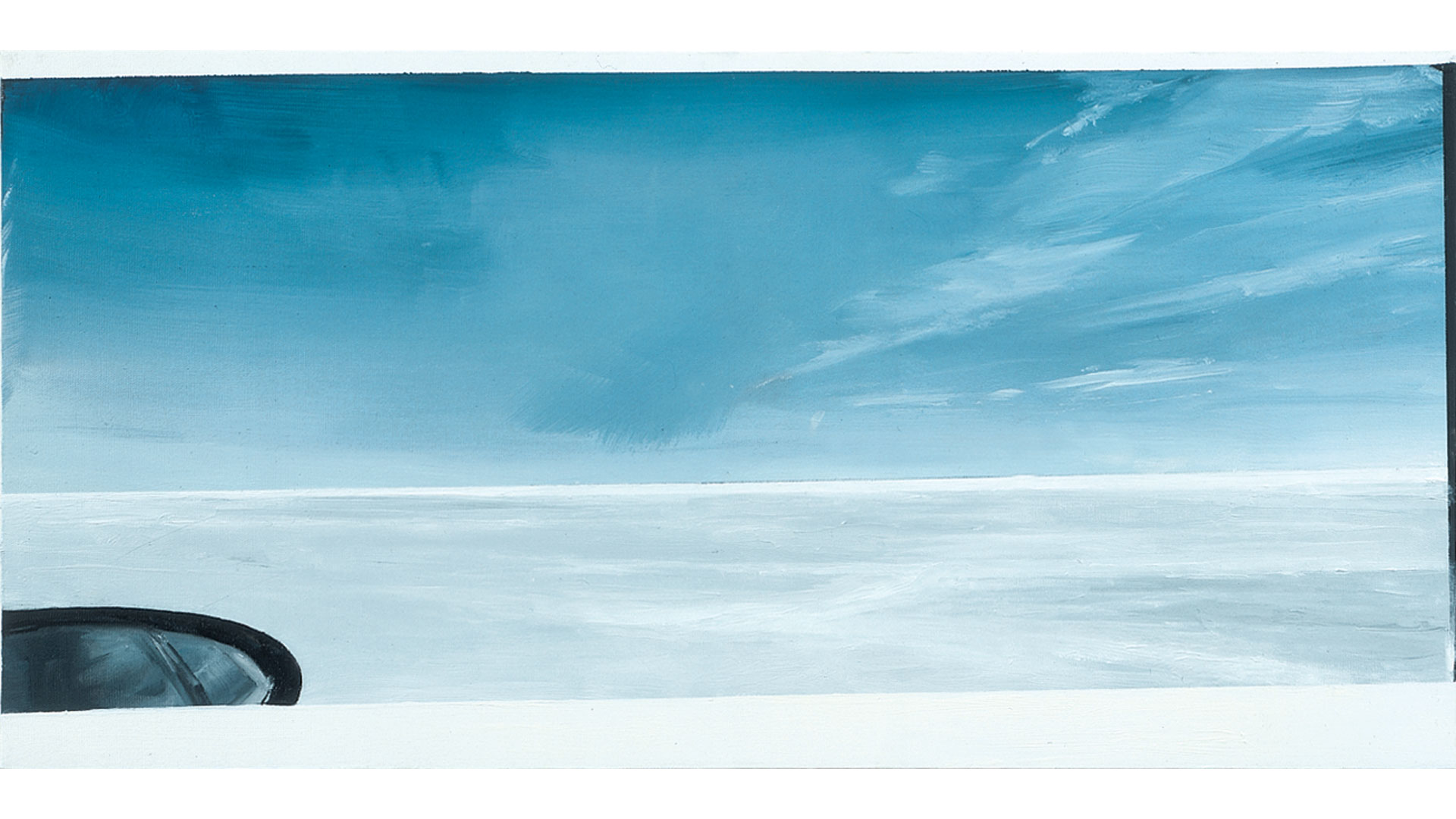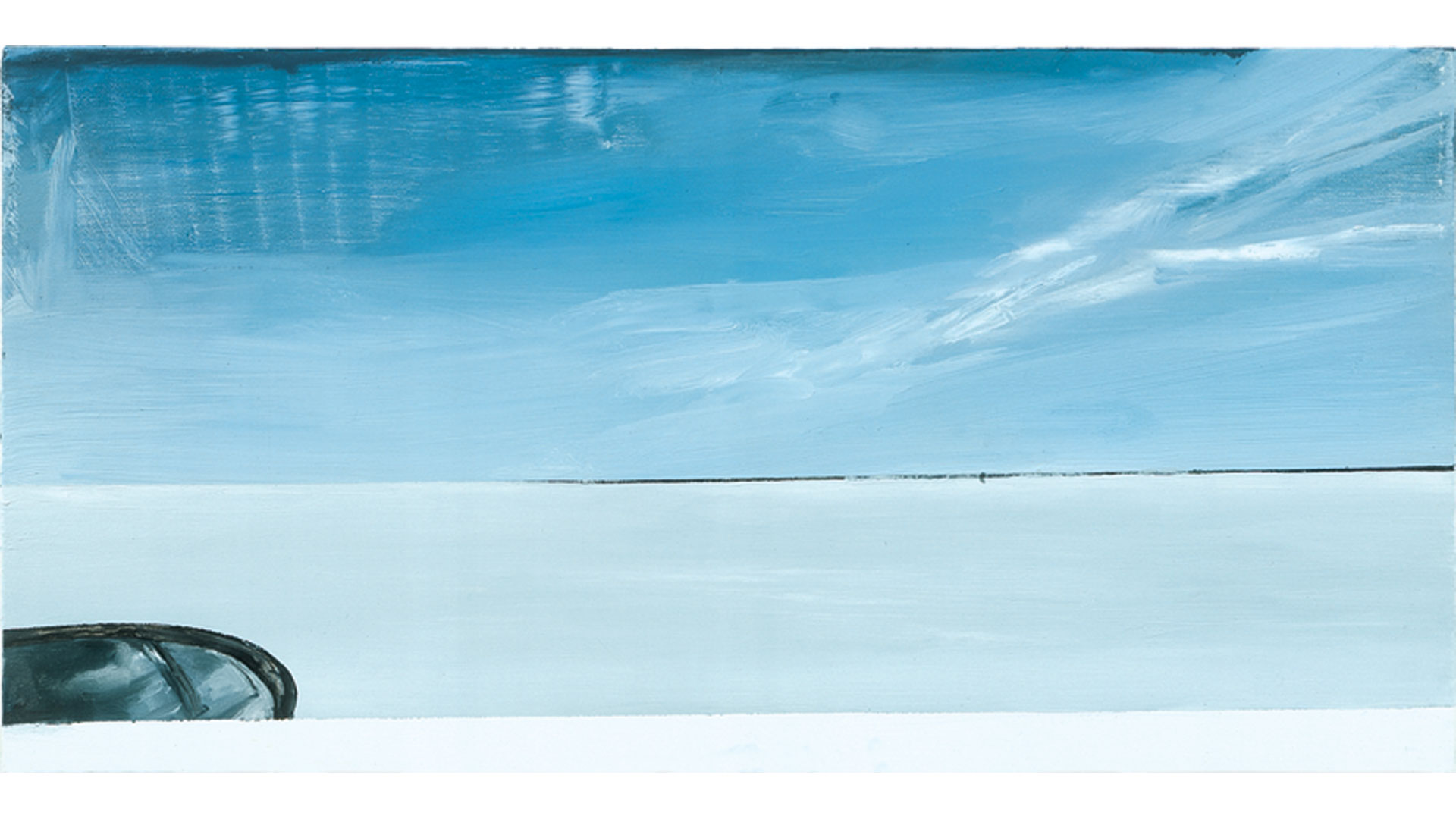UNTITLED by Heidi Zuckerman Jacobson
Director and chief curator Aspen Art Museum
August 2005
What is the difference, one could ask, between being present at a site that is pictured and looking at that landscape via a painting? Earlier this year, Carla Klein traveled to the United States in order to make a series of paintings. Driving in Utah and especially the Salt Lake Desert region, she shot hundreds of photographs using digital cameras as well as a wide angle camera. She decided to visit the area on the basis of photographs and pictures that reminded her of the paintings she had produced of the landscape in Finland. Klein experienced Utah especially through her cameras. The physical mode of vision inherent in this process allows and promotes distance. And it is from a distance that things often become visible.
Continue reading
Klein paints directly from her photographs. Asked how she chooses the photos from which to paint, she indicates their possession of a hard to describe ‘special quality’. She not only prints her own photographs in the darkroom but also manipulates the image, changing the colours while processing in order to produce the desired image Klein is one of an impressive group of contemporary artists, including Peter Doig and Wilhelm Sasnal, who employ photographs as the source material and basis of their paintings. Sasnal, like Klein, leaves out much of the original image in his paintings. He concentrates on formal elements and removes all of the discordant surroundings. Dig paints from postcards, newspapers, popular films and often from his personal photographs, whether taken or found by him, or a friend or family member. He ‘uses the photo like a map, but not as tracing, Just as a way of giving me a foot into a kind of reality that I want’ (1) Klein stated, ‘I use photographs as a basis for my paintings and you should feel that in the final result. The photograph is, however, in itself not a reliable representation of reality, but an image with a reality of its own that I can put to my own use, can manipulate… Reality very much depends on your point of view.(2) Photographs are, of course, a way by which to retain memory. How else can a moment be remembered in one’s own mind, recorded eternally? People exclaim: ‘I do not ever want to forget this moment’, while snapping away. It is even possible that reliance on memory capacity decreases as recording devices that assist with remembering increase.
Klein is inherently direct in the conversion of the selected and modified photographs into paintings; all of the processing characteristics that appear in the photographs get painted: finger prints, hairs and splashes of water. The horizontal band of white often found at the base of her paintings portrays the photographic paper. It doubles as grounding or base for the image and also provides an abstract element. It is within these conscious choices that the artist highlights the essence of her practice: when looking at a Klein painting, what you see is a painting, not a photograph. This is not to say that her works lack the magic of illusion as, in fact, Klein aims for a duality. The viewer encounters, is seduced and ultimately astonished by the combination of severe borders – achieved by using masking tape to get perfectly straight lines – and the painterly variability that reveals the artist’s hand.
Often stark, Klein’s compositions contain deep perspective and hold a single architectural element or series of abstracted forms. She paints natural and manmade landscapes: airports, swimming pools, environments that are completely known and non-natural. She chooses places that are ‘inhabited on a transitory, rather than on a permanent basis Spaces that provide a prolonged experience’.(3) For her MATRIX show, Klein began a new body of work concentrating on the natural environment. These landscapes, along with all of her earlier works, lack human presence. As such, there is an implied loneliness to the interiors and a perceived freedom to the exteriors.
Klein is intrigued with the notion of bending reality. Her works question how far something can be stretched and still appear real and recognisable. Johanna Burton wrote, What’s weirdly compelling about them is how alive they seem even when they aren’t occupied – when their geometry is allowed, momentarily, to waver’ .(4) At times, upon close inspection, the image falls apart. Klein explained that she used to be engaged with the conversion of small images to life size. She realised, though, that we do not know what size nature is; for example, how big is the Salt Lake Desert really? She is drawn to the abstraction that can be located within a landscape – that the same site can be simultaneously flat and deep. Klein has painted several images of tunnels. In them there is an emotional resonance that alludes to an entry barrier, a force that nonetheless compels one to enter. Here the painted space is both opened and closed.
Klein employs a limited, Minimalist palette. She paints in oil and enamel using primarily black and shades of white and blue. She occasionally uses some green and yellow in smaller elements. Her process is related to the grey paintings of Gerard Richter, a talented and multifaceted artist who moves adroitly between varied painting styles and photography and is as masterful at one as at the next. He, along with Dutch master of light and intimacy Johannes Vermeer, site-specific environmental artist Walter de Maria, and Barnett Newman, has been cited by the artist as an influence.
Klein often creates complementary works. Included here is a triptych of sorts, which features the sky and the horizon line. The cloud formations are dynamic and filled with a communicated motion. It is possible that within them the presence of the divine could be fathomed. Critic Philip Peters wrote, ‘In the end, I believe that Carla Klein’s work is about this about the risk of uncertainty, about the meaning of meaninglessness, about the critical moment in which nothing is sure, about a constant state of flux, the condition of art and of the artist’.(5)
All of Klein’s paintings are untitled. One could infer, as they are nameless, that they are unidentifiable and subsequently unknowable. The other extreme is that they are instead universal, ubiquitous, not requiring a name. Due to their primarily large scale, which fills the peripheral vision of the viewer, and the otherworldly color schema, the absence of nomenclature implies their location in the unknowable. There are no names because none are available. The distance between being in a place painted by Klein and being in front of a painting of Klein is a melancholic journey into a deep and sacred space. Those who boldly enter may emerge forever altered.
The feelings of incomprehensibility and true awe generated by pristine and sublime environments are inaccessible while solely living in an urban environment. On vacation, countless photographs are taken of requisite natural icons: waterfalls, mountains, salt flats. Again, the intention is to retain somehow these images as other impressions will replace these more peaceful and inspiring ones upon returning home the mundane rushes in – often harshly – to replace the idyllic.
No one wants to sit through someone else’s memories: slideshows, home movies, PowerPoint presentations, and photo albums. This reluctance is based on a] they have their own (even if they will never look at those again), and b] photographic images of nature (and other images devoid of people) just do not convey the real feeling. Everyone knows that ‘You just had to be there’. When Klein translates this type of image into a painting, however, it is transformed. She paints that same or similar scene over and over again. The details become more accessible and apparent by looking at the subtle differences among theimages. For example, the angle of the earth where it connects to the point of the car – pictured here only as an abstract black form (the dashboard) – is thirty instead of ninety degrees. Each individual manifestation retains its uniqueness and allure. There is within our daily lives the repetition of events, actions, and locations. Much like the life of the character played by Bill Murray, the protagonist, in the popular film ‘Groundhog Day’, some or all things must be done repeatedly – until they are perfected. Klein paints and paints and we, the viewers, look and look. It is here within this process of looking that we can learn to see. There, within the details, is something that can be termed grace.
Heidi Zuckerman Jacobson
Director and Chief Curator
Aspen Art Museum
August 2005
1. Adrian Searle,’I’ve never been canoeing on a toxic swamp. (A conversation with Peter Doig)’ Blotter (Berlin and London Contemporary Fine Arts and Victoria Miro), 1995, p 10
2. 2 P. van der Lugt , K Baars, ‘Carla Klein and Charlotte Schleiffert’, Attitude
3 (Stadsgalerij Heerlen), 1998, pp 7 – 113 Micaela Giovannotti, “Carla Klein’ 3. ‘Tema Celeste: contemporary art’, October/December, 2000, p 79
4. Johanna Burton, ‘Carla Klein’, Time Out New York, January 10-17, 2002, p. 625
5. Philip Peters, “Heeft het schilderij ‘ Green Easter (Museum Dhondt-Dhaenens, Deurle) 1997, pp 37-47
The Secondary Brilliance of the Journey Begins: On Recent Work by Carla Klein by Johanna Burton
August 2005
Driving is a spectacular form of amnesia. Everything is to be discovered, everything to be obliterated. Admittedly, there is the primal shock of the deserts and the dazzle of California, but when this is gone, the secondary brilliance of the journey begins, that of the excessive, pitiless distance, the infinity of anonymous faces and distances, or of certain miraculous geological formations, which ultimately testify to no human will, while keeping intact an image of upheaval. This form of travel admits of no exceptions: when it runs up against a known face, a familiar landscape, or some decipherable message, the spell is broken: the amnesic, ascetic, asymptotic charm of disappearance succumbs to affect and worldly semiology.
—Jean Baudrillard[1]
Continue reading
Recently, Carla Klein took her show on the road, which is to say that a number of the paintings she has produced in the last months are based on snapshots made while driving (or, alternatively, while being driven, as the case usually seems to be) across the United States. These source photographs, as they may be somewhat imprecisely labeled, are of the variety with which many of us have filled our own rolls—hurtling cross-country down sparse, baked, two-lane rural highways, the light catching the pavement just so, each click of the camera an attempt to capture another overwhelming, perpetually unfolding vista, to document what it feels like to be there and there and there. (These instantaneously occupied, ultimately interchangeable, points of reference seem, at the time, completely, if ungraspably, unique.) The landscape, so endlessly fascinating, morphing every instant into something new—somewhere new—is impossible to describe, so we do what we can to capture its flickering material likeness on film. Atmosphere and terrain are filtered through (and framed by) the windshield, that thin glass membrane shielding travelers’ skin from the elements while allowing their eyes to pick up every visual facet, every crisp ray of sun- or moon-light. Never mind where you’re on the way to, forget the concept of destination. This is, counterintuitive to our usual goal-oriented tasks, all about the journey. Road trips may be understood as one of the last truly Romantic acts, pilgrimages whose end-points exist only in the middle and whose dearly held relics amount to little more than fingernail clippings: referring to but indelibly severed from their living contexts.
The method of taking pictures that necessarily ensues is a bit like shooting blanks, and not just in the metaphoric sense. You may come away with hundreds, even thousands of images that en masse are meant to offer some clue, some sustainable evidence, as to where you’ve been or, better, what it was like to not be anywhere exactly and yet to feel precisely, if rather schizophrenically, located. Nevertheless, fresh back from the Photomat, nine times out of ten, the photographs are not only unspectacular, but they are also virtually empty: long expanses of creeping horizon-line, with colors below and above bleached uniform brown and blue and white, the road ahead no longer an animated being but instead a stationary, ossified thing. There are hardly any details, save a stray road sign or your own rearview mirror, and these were not really what you were looking at, not really what you saw, even if they were the most consistent markers in your field of vision. This pile of snaps, spread across your kitchen table in their multiplicity (you’ve pawed through them already, thinking there would simply have to be one transcendental, breathtaking image but found you were wrong), suggests a strange approximation. They look like frames, empty frames whose content has somehow managed to partially slip away from the inside. It was there, you can still sense traces of it even if you can’t say what it was. The absence of access to all those now past presents is all the more acute because they are nearly palpable in their presence.
But this is, of course, the nature of photography as Barthes so elegantly postulated it—as bodying forth the “that-has-been.”[2] This conception of Barthes’s has been endlessly cited, for it succinctly expresses all that photography is and, for that matter, all that it isn’t. That is to say, the photograph can only show what is gone; it cannot, by terms of its own material and temporal limitations, show what stands in the present. It is precisely a marker of what came before (before in time, before the lens, before the thumping tires of your speeding car). Unless, that is, one considers absence its own kind of presence.[3] Or, taking things a step further, unless one considers absence something waiting to be filled, as not only a kind of inverted presence but as a kind of (shaky) future anteriority—a “this-will-be.” Looking at all these surprisingly empty frames (a.k.a. road trip landscapes), one can nearly will the latter idea into plausibility. There is nothing to see and yet one keeps looking, squinting deeply all the same, combing the 3 X 5 rectangle for some clandestine kernel to emerge, like a pearl sifted from sand. Besides, Barthes has a second way of describing photography: “the Intractable,” he calls it.[4] This is hardly a word that conjures the fleeting, the ephemeral, the “always already deferred” that places the content of every photograph squarely in past. Derived from the Latin intractabilis [un + treatable], “intractable” implies obstinacy and unruliness, a flat-out refusal to behave in any prescribed or conventional manner. So, while the photograph is often heralded for its fragility, its ephemerality, its barely-thereness, one should also consider that such slipperiness stands not only for the vulnerability of the medium but as its strength (and stubbornness) as well.
It is precisely the stubbornness of the photograph that compels Carla Klein’s use of it. She is, quite importantly, not a photographer, though she more often than not takes her own photographs; she is, rather, a painter who works from and with the photographic image, complicating ideas of direct representation exponentially. Of course, painting from photographs is nothing new, and the fraught relationship between the mechanical and the expressive; the “objective” and the intuitive; the reductive and the additive has been (arguably overly) thought through for decades. But these are dialectics that exist almost as a matter of course in Klein’s work, which forcefully contends with painting’s hearty historical baggage without taking it as sole content, and with photography’s immanent relationship to lack as an unexpected pregnant possibility. Quite stunningly, Klein focuses on painting as a means to conjure back into the photograph what has seeped out of it. This is not to say that painting operates as a positive where photograph acts as negative; quite the contrary. It is to speculate that the flicker between photography and painting, in Klein’s hands, offers up access to a quite liminal space and time—one that is neither now nor then; here nor there but somewhere suspended between them. And this is not to suggest that her version is imprecise: Klein’s are crystalline visions of quiet, perhaps even mute, exactitude—spaces overflowing with their own emptiness.
The fact that these are images at once viscerally familiar and yet elusive of easy linguistic identification speaks to the epigram for this essay, where Baudrillard compares driving across America to amnesia (another breed of empty-fullness were there ever one). “After the primal shock,” he writes, “the secondary brilliance of the journey begins.” Secondary brilliance, which is at once gorgeous and ghastly, split-second and interminable, casts a kind of spell, one which, web-like, renders every mile of landscape into something new, something “discovered” only at the very moment it is destroyed, literally passed over and by—“obliterated,” Baudrillard calls it. His use of the term obliteration is far from accidental: Its 17th-century Latin etymology can be decoded as “against script” or, more loosely, “effacing letters.” Amnesia, then, can be understood, at least in Baudrillard’s simulacral world, as a temporary suspension not simply of memory but of memory’s relative, linguistic operations. (Pace Saussure: “In language there are only differences.”[5]) Amnesia disallows meaning born of comparison, since it wipes clean the slate of prior experience and leaves only empty frames of referencelessness—much like those offered by Klein.
Klein’s road trip was largely conducted on the West coast, though it’s hard to tell by looking at her paintings. None of Baudrillard’s “primal shock of the desert” or “dazzle of California” is recorded here, at least not in the usual ways. Instead, Klein turns forcefully to what Baudrillard calls “secondary brilliance,” which locates itself precisely in areas, on the canvas and off, that appear to be quite vacant and yet emit a sort of low visual hum, putting into question any gauge of absence. Klein’s hum can first be heard by way of her palette: cool, watery grays, greens, blues, and whites that have neatly embodied glistens, gleams, shimmers, and translucencies since Dutch still-life painters used them in the 17th century. (An artist from the Netherlands herself, Klein is an interesting example of a painter who renders the landscape—both natural and manmade—its own version of nature morte.) The works seem to chart times of day, for when looking attentively at them, one discerns that the brightness, angle, and opacity of light vie for attention with any object bathed in its paint-concocted rays. (Although, interestingly, for all the precision of light, season is often confounded. Is that surface, cut by lines of past travel, bleached desert sand or, rather, thickly crusted snow? Can the sharpness of light there be attributed to warmth or chill?) While such shifts might initially be taken for “mood,” the impulse to read drama or intrigue into things is abruptly done away with. There is no narrative here, no characters, no grounding in the luxuries of theatrically endowed premise. If the sky is bright, it is likely due to no more than the way the sun shines midday in the heat of summer; if it is dark, maybe the time of season is early fall, perhaps there is a storm on the horizon, or night is simply falling. Nothing more. Pathetic fallacy marks the naval-gazing way we typically understand the world without stepping outside of the human economy. Yet, Klein’s canvases, which obstinately focus on all that we normally disregard (all those insignificant details that frustrate us in our own “empty” pictures) refuse to mirror us back to ourselves in this way.
And yet, for works so “empty,” there is so much there. Simply put, these are landscapes, clearly modeled on photographs taken while in a car. Sometimes, there is only a slight hint of the windshield or side-window, a subtle glint marking its transparent presence. Other times, the interior of the car asserts itself more aggressively, and one’s eye is directed to equipment (a video camera?) propped on the dashboard, or to the reflections caught in the rearview mirror, or to the curves of the metal that make up a side- window frame. But no matter the precise set-up of the painting, there is a kind of dialogue induced, formally rather than theatrically, between the inside and outside of the car, and between the moment of the shot’s capture and the painted format in which it now finds itself. As much as these images lean and even press on definitions of the photographic, they slip into flirtations with the filmic as well. The paintings, for all their sparse expanses, are often executed on enormous canvases whose length is some twice their height and which nevertheless give the feel of “the-original-presentation-has-been-formatted-for-your-television” scaling. This is because, no matter how large, they still capture a mere fraction of the world’s “original” dimensions, regardless of the fact that they are actually modeled on photographs small enough to be held in the palm of your hand.
Such fluidity of scale manifests in a number of ways. Not only do the paintings look as though they are simultaneously smaller and larger than what they “actually” represent (i.e. the “real” site and the photograph of it), they also shuttle, rather in the mode of the duck-rabbit game, between abstraction and figuration (though here without any figures). As much as the landscapes themselves can, at a glance, be described as sparse, the paintings themselves, qua paintings, can only be called lush, full, even gorged—the manifestation of emptiness incongruously achieved. There is no confusing the surface of the work with a photograph, no matter where one stands in a room. (If there is anything photorealistic here, it is, ironically enough, only the attention to what in the photographic is normally disregarded for not having enough “picturesque” detail—something that shows us how painting-like we demand our photographs to be.) Scale, or the sliding of scale, is something Klein negotiates with agility, skillfully and insistently pairing the abstract with the representational. So many of her driving shots could be superficially aligned with Ab-Ex compositions, with their bands of condensed color suggesting a confluence of thick materiality and spiritual escape from the worldly. Yet, such comparisons, while delicious (one of Klein’s nearly black-and-white interior car shots is a perfectly secularized Motherwell) are limiting. After all, the notion of the autonomous object is antithetical to Klein, whose own canvases reveal their contingency baldly: why else paint what could only be photo borders along the peripheries of a painting?
It is helpful, in this vein, to narrate a quick teleology for Klein’s career, which has always complicated and conjured the relationship: empty/full. Indeed, since the beginning, she has stealthily pursued the ways in which, when one thing disappears, another appears on the proverbial horizon—however initially invisible to the eye (secondary brilliance often goes unnoticed). While she is known for presenting public places eerily divorced from the public that ostensibly occupies them, some of her earliest works did allow for bodies of a kind: those found in Natural History Museums (taxidermied, pinned, petrified) or morgues. But even then, one could see the bodies as little more than (emptied) vessels themselves, and it was clear that her interest wandered to surfaces of presentation: panes of glass and wood structures that so easily could be seen as frames. Thus, every display case was already isolating its contents into potential photographs and paintings, into representations before they were even thought as such. So, why bother with the contents, Klein seemed to decide, if they are the given? The artist went on to paint terrariums (without occupants), swimming pools (without swimmers), modern houses (nobody home), bridges (untraversed by cars), sports stadiums (between events), televisions (switched off), airport terminals (planes circling rather than clearly departing or arriving), and entryways for city subways like those in every metropolis, save the fact that these are (disquietingly) deserted. Klein’s work has often been discussed in terms of alienation, and particularly with relation to the kind of spaces to which she seems most drawn (Marc Augé has famously nominated similar sites “non-places”[6]): liminal spaces devoid of cultural histories or lasting social engagement. And yet, for all the satisfying melancholy of Klein’s images and the way they do, in fact, approach a certain breed of globalized space, they do more than make visual comment on a world increasingly filled (with bodies) and emptied (of meaning). Whether a tiny terrarium (which painted just so looks to be a monstrous modernist construction) or an enormous stadium (which painted just so looks to be a feather-light model), Klein has been painting so many versions of landscape, fleeting instances captured by the camera and then re-thought, re-invested by the paintbrush.
If it is somewhat more obvious to see how Klein’s works can be thought in terms of landscape with her newest canvases—those that I’ve been calling her “road trip” paintings—consider the ways in which every one of her paintings documents a place of some type of passage. For one reason or another (and for one length of time or another), one is always moving through, crossing, traversing, or visiting the sites she focuses on (even the homes we occupy, the offices we work in, can be thought this way). Yet, rather than simply reading these as places we feel no real connection to or, worse, that effect a kind of post-post-modern ennui, one can think them through more ambivalently. Indeed, to consider Klein a contemporary landscape painter is to recognize the emptiness of her paintings but to see in that emptiness a particular fullness, too. Her skies, often filled with lavish clouds that perpetually threaten to turn into brush-strokes, are breathtaking examples of so-little-so-much. Barthes, who spoke almost exclusively of people as represented in photographs, did have this to say about photographs of landscape: “Looking at these landscapes of predilection, it is as if I were certain of having been there or of going there.”[7] Here, Barthes allows a strange confluence of the “that-has-been” and what I earlier called a “this-will-be,” a bringing together of the past and an as-yet undetermined future. And in Klein’s landscapes—by which I mean all her work—this sense of a past that has a future hovers between camera and brush—by which I mean on the canvas. It is there in abundance—just look closely where it appears there is nothing much to see.
Johanna Burton
August 2005
[1] Jean Baudrillard, America, trans. Chris Turner (London; New York: Verso, 1988), 9-10.
[2] Roland Barthes, Camera Lucida, trans. Richard Howard (New York: Hill and Wang, 1981), 77.
[3] For a brilliant read on the photograph embodying the presence of absence in postmodern art, see Douglas Crimp, “The Photographic Activity of Postmodernism,” October, no. 15 (Winter 1980).
[4] Barthes, ibid.
[5] See Ferdinand de Saussure’s Course in General Linguistics, trans. Wade Baskin. (New York: McGraw-Hill, 1960).
[6] Marc Augé, Non-Places: Introduction to an Anthropology of Supermodernity, trans. John Howe. (London; New York: Verso, 1995).
[7] Barthes, 40.
